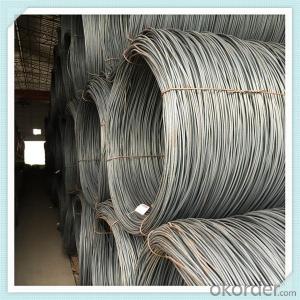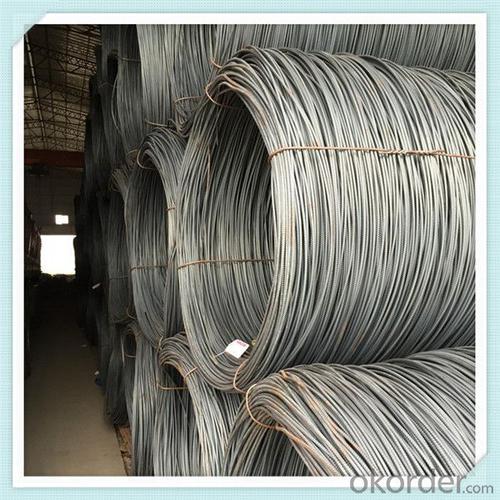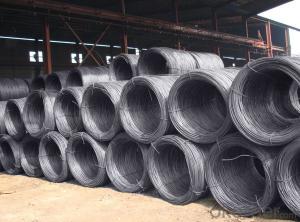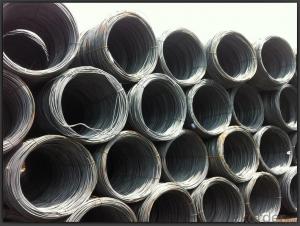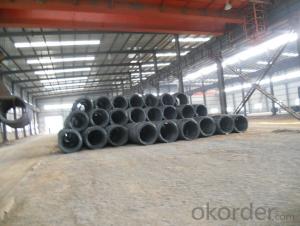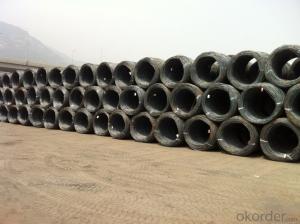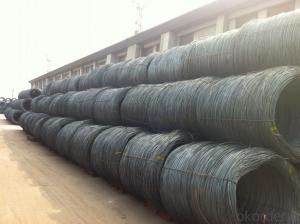Hot rolled steel wire rod SAE1008-SAE1018
- Loading Port:
- Qingdao
- Payment Terms:
- TT OR LC
- Min Order Qty:
- 100 m.t.
- Supply Capability:
- 15431 m.t./month
OKorder Service Pledge
OKorder Financial Service
You Might Also Like
Specification
Features
1、Pure steel quality, stable chemical contents, small tolerance.
2、Constant Quality, good drawing performance.
3、High dimension accuracy degree, accuracy degree of Level C up to 80%, smooth surface, less scale,
easy to be pickled.
4、Automatic bundling with 4 lines by Machine in tidy and good looks
5、Big high quality percentage, small coil percentage, and heavy coil weight for Hard Coil.
6、High sorbitizing percentage.
Our Advantage: High quality steel products from 1 class mills in
Reasonable price
Professionalism of the products
On-time delivery
Complete documents and certificates
Sincere service to meet our clients' requirements
Product Description :
Standard | AISI, ASTM, BS, DIN, GB, JIS |
Material/steel grade | Q195-Q235,SAE1006B,SAE1006CR, SAE1008B, SAE1008CR, SAE1010B, SAE1018B, or according to customers requirements |
Wire Gauge | 5.5-12mm |
Coil weight | 1.8-2.1mts |
MOQ | 25MT |
Delivery Time | 15-30 days after receipt of L/C or deposit by T/T |
Packing | In coil and load in container, if large quantity, by bulk vessel; Can be packed as customers' special requirements |
Payment terms | 1).100% irrevocable L/C at sight. 2).30% T/T prepaid and the balance against the copy of B/L. 3).30% T/T prepaid and the balance against L/C |
Application | widely used in machinery parts, manufacturing industry, electronics industry, metal tools and others |
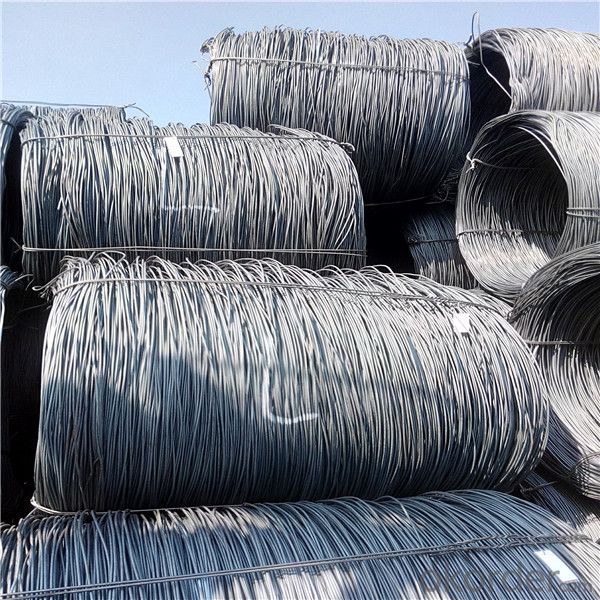

Application :
It generally used in braiding the hose for bathing product and machinery. With it
good flexibility, resistant to high temperature and resistant to corrosion, it
used widely in many industries.
Packing :
Hot-rolled wire rod is held in a unit with at least four steel straps in the
transverse direction and transported and stored without further packaging.
Before
the steel strapping is applied, the wire rod must be sufficiently compressed.
The strapping is fixed in the transverse direction with a single circumferential
strap so that the strapping does not slip and cause the coil to come apart.


Our service:
(1) We cooperate with famous factories with advanced equipment and well trained workers.
(2) We can provide factory price with trading company service.
(3) We continuously work on the improvement of our processes, guaranteeing
consistently high standards of quality to keep none compensation.
(4) We guarantee 24 hours response and 48 hours solution providing service.
(5) We accept small order quantity before formal cooperation.
(6) We deliver the agreed quality at the agreed time, reacting to changes in
customer wishes in a flexible way.
(7) Due to our volume and selling power, we have excellent freight rates with
shipping lines.
(8) We strive to always be fair and honest in our dealings with customers.
(9) We strive to work together with customers to achieve much more than we can
achieve alone.
(10) Through our passion and commitment we aim to be a market leader in all our
key markets. To maintain our position as market leader we must continue to add
value in all that we do.
FAQ:
1.Q: What's your MOQ(minimum order quantity)?
A: One full container, mixed acceptable .
2. Q: What's your packing methods?
A: Packed in bundle or bulk ..
3. Q: How can I buy CNBM products in my country?
A:Please send us an inquiry or email ,we will reply to you if there is distributor in your country
4. Q: Can we visit your factory?
A: Warmly welcome. Once we have your schedule, we will arrange the
professional sales team to follow up your case.
5. Q: How long does it take to get the product if i place an order?
A:With the process of your requirements,we will pack and deliver in 3
-7 days. If it is by sea shipment,it will take 15-45 days depending on different locations
- Q: How is steel wire rod used in the production of wire for musical instruments?
- Steel wire rod is an essential component in the production of wire used for musical instruments. It serves as the raw material that undergoes various manufacturing processes to transform it into the desired wire form. Firstly, the steel wire rod serves as the starting point for creating different gauges of wire required for different musical instruments. It is typically made from high-quality steel with specific chemical compositions and mechanical properties that ensure the desired strength and durability of the final wire product. Once the steel wire rod is obtained, it undergoes a series of processes such as drawing, annealing, and tempering to achieve the desired characteristics. Drawing involves pulling the wire rod through a series of dies to reduce its diameter and increase its length. This process helps in refining the wire's surface finish and improving its tensile strength. Annealing is another crucial step that involves heating the wire to a specific temperature and then slowly cooling it. This process helps to relieve internal stresses, improve the wire's ductility, and enhance its ability to resonate when used in musical instruments. After annealing, the wire may undergo further processes like tempering, which involves heating the wire to a lower temperature and then cooling it rapidly to achieve specific hardness and springiness. This step is crucial in creating wire with the desired flexibility and responsiveness required for various musical instruments. Once the wire is produced, it can be used in the construction of different musical instruments. For example, steel wire is commonly used in the production of guitar strings, piano wires, and various brass instruments. The specific gauge and composition of the wire are carefully selected to produce the desired pitch, tonal quality, and playability of the instrument. In conclusion, steel wire rod plays a vital role in the production of wire for musical instruments. It serves as the raw material that undergoes various manufacturing processes to create wires of different gauges, strengths, and tonal characteristics. These wires are then used in the construction of various musical instruments, contributing to the creation of beautiful sounds and melodies.
- Q: What are the common methods used to remove surface defects in steel wire rod?
- Surface defects in steel wire rods can be eliminated through various methods. Mechanical polishing, for instance, employs abrasive materials like sandpaper or grinding wheels to effectively eradicate imperfections and achieve a smooth and even surface. Chemical pickling, on the other hand, entails immersing the wire rod in an acid bath, wherein the acid reacts with the impurities on the rod's surface, leading to their dissolution and leaving behind a pristine surface. This method is particularly effective in removing scale, rust, and other oxidation products. Electrochemical cleaning involves passing an electric current through the wire rod while it is submerged in an electrolyte solution. This current causes the surface defects to dissolve and migrate away from the rod, ultimately resulting in a cleaner and smoother surface. Shot blasting is a widely employed technique that propels small metal or abrasive particles at high velocity onto the wire rod's surface. The impact of these particles effectively removes defects and contaminants, leaving behind a clean and textured surface. Lastly, chemical passivation is a commonly used method for stainless steel wire rods. It involves immersing the rod in a chemical solution that forms a protective oxide layer on the surface, eliminating defects and preventing further corrosion. In conclusion, these methods are frequently utilized in the steel industry to eliminate surface defects in wire rods, depending on the specific type of defect and the desired outcome.
- Q: How is the steel wire rod market affected by changes in trade policies?
- Changes in trade policies can have a significant impact on the steel wire rod market. Trade policies such as tariffs or quotas can influence the supply and demand dynamics, production costs, and competitiveness of steel wire rod producers. When trade policies impose tariffs on steel wire rod imports, it can increase the cost of importing the product, making it more expensive for domestic manufacturers to source raw materials. This can lead to an increase in the price of steel wire rod in the domestic market, affecting the profitability of manufacturers and potentially reducing the demand for the product. Conversely, if trade policies impose tariffs on steel wire rod exports, it can limit the market access for domestic manufacturers, reducing their ability to sell their products internationally and potentially impacting their revenue. Quotas on steel wire rod imports can also have a significant impact on the market. When quotas are imposed, it limits the quantity of imported steel wire rod that can enter the domestic market. This can lead to a decrease in supply, potentially creating a shortage in the market and driving up prices. On the other hand, if quotas are imposed on steel wire rod exports, it may restrict the ability of domestic manufacturers to access international markets, reducing their market reach and potentially affecting their profitability. Changes in trade policies can also impact the competitiveness of domestic steel wire rod producers. If trade policies favor domestic producers by imposing higher tariffs on imports, it can provide a competitive advantage to domestic manufacturers by making imported steel wire rod more expensive. This can incentivize domestic production and potentially lead to increased investment in the industry. Conversely, if trade policies favor imports by imposing higher tariffs on exports, it can hinder the competitiveness of domestic producers, making it difficult for them to compete in international markets. Overall, changes in trade policies can have both positive and negative impacts on the steel wire rod market. The extent of these impacts depends on the specific trade policies implemented and the reactions of market participants.
- Q: How is steel wire rod used in the manufacturing of wire partitions?
- Steel wire rod is used in the manufacturing of wire partitions by being processed through various stages including drawing, annealing, and coating to form strong and durable wires. These wires are then woven or welded together to create the framework of wire partitions, providing stability and security.
- Q: How is the quality of steel wire rod measured?
- The quality of steel wire rod is typically measured using various physical and chemical properties such as diameter, tensile strength, ductility, surface finish, and chemical composition. These measurements help ensure that the steel wire rod meets the required standards and specifications for its intended use in various industries.
- Q: How is steel wire rod used in the manufacturing of wire forms for industrial machinery?
- Steel wire rod is an essential component in the manufacturing of wire forms for industrial machinery. It is a raw material that is extensively used due to its durability, strength, and versatility. Wire forms are intricate shapes made from steel wire rod that are used for various purposes in industrial machinery. They can be bent, twisted, or shaped into different configurations to meet specific requirements. One of the primary uses of steel wire rod in the manufacturing of wire forms is for structural components. These forms provide stability, strength, and rigidity to the machinery. Steel wire rod is processed and transformed into wire forms such as springs, clips, brackets, and hooks, which are crucial in holding different parts of the machinery together. Additionally, steel wire rod is used in the manufacturing of wire mesh, which is commonly used as a safety barrier in industrial machinery. Wire mesh made from steel wire rod provides a protective layer, preventing any potential hazards from reaching operators or other sensitive components. Moreover, steel wire rod is also used for electrical purposes in industrial machinery. It can be transformed into wire forms that act as conductors, allowing the flow of electricity throughout the machinery. This is particularly important in machines that require precise electrical connections and control systems. Overall, steel wire rod plays a vital role in the manufacturing of wire forms for industrial machinery. Its strength, durability, and versatility make it an ideal material for creating structural components, safety barriers, and electrical conductors. Without steel wire rod, the production of wire forms for industrial machinery would be significantly compromised.
- Q: How is steel wire rod used in the manufacturing of wire forms for automotive components?
- Steel wire rod is used in the manufacturing of wire forms for automotive components as it serves as the primary material for creating the structural framework of these forms. The steel wire rod is processed through various techniques such as cutting, bending, and shaping to create specific wire forms required for automotive components like springs, brackets, clips, and fasteners. Its high tensile strength and durability ensure that these wire forms can withstand the rigorous demands of automotive applications, providing stability, support, and functionality to the components they are integrated into.
- Q: What are the different types of steel wire rod surface treatment processes?
- There are several different types of steel wire rod surface treatment processes that are commonly used in various industries. These processes are designed to enhance the properties and appearance of the steel wire rod, as well as to protect it from corrosion and other forms of damage. Here are some of the most commonly used surface treatment processes for steel wire rods: 1. Pickling: Pickling is a process that involves removing impurities, such as rust and scale, from the surface of the steel wire rod. This is typically done by immersing the wire rod in an acid solution, which dissolves the impurities and leaves the surface clean. 2. Phosphating: Phosphating is a process that involves coating the surface of the steel wire rod with a layer of phosphate. This layer provides corrosion resistance and acts as a base for subsequent surface treatments, such as painting or powder coating. 3. Galvanizing: Galvanizing is a process that involves coating the surface of the steel wire rod with a layer of zinc. This layer provides excellent corrosion resistance and can be applied through either hot-dip galvanizing or electroplating methods. 4. Electroplating: Electroplating is a process that involves depositing a thin layer of metal, such as zinc or chrome, onto the surface of the steel wire rod. This layer provides enhanced corrosion resistance and can also improve the appearance of the wire rod. 5. Coating: Coating is a process that involves applying a thin layer of protective material, such as paint or powder coating, onto the surface of the steel wire rod. This layer provides corrosion resistance and can also enhance the appearance of the wire rod. 6. Passivation: Passivation is a process that involves treating the surface of the steel wire rod with a chemical solution to remove any free iron or other contaminants. This process helps to prevent corrosion and improves the passive film on the surface of the wire rod. These are just a few of the many different types of surface treatment processes that can be used for steel wire rods. The specific process chosen will depend on the desired properties and requirements of the wire rod, as well as the intended application.
- Q: How is steel wire rod used in the production of wire mesh for food processing?
- Steel wire rod is used in the production of wire mesh for food processing as it serves as the primary material for creating the mesh grid. The wire rod is first drawn into the desired thickness and then woven or welded together to form the mesh structure. This mesh is then used in various food processing applications such as sieving, filtering, and straining to ensure the quality and safety of food products.
- Q: How does the price of steel wire rod fluctuate in the market?
- The price of steel wire rod fluctuates in the market due to a variety of factors. One significant factor is the supply and demand dynamics within the steel industry. When there is a high demand for steel wire rod, such as during periods of economic growth or construction booms, the price tends to increase. Conversely, when there is a decrease in demand or oversupply of steel wire rod, the price tends to decrease. Another factor that affects the price of steel wire rod is the cost of raw materials. Steel wire rod is typically made from iron ore, which is subject to price fluctuations in the global market. If the cost of iron ore increases, it can lead to higher production costs for steel manufacturers, resulting in higher prices for steel wire rod. Additionally, fluctuations in energy prices can impact the price of steel wire rod. Steel production requires a significant amount of energy, particularly in the form of electricity and natural gas. If energy prices rise, it can increase the cost of production, leading to higher prices for steel wire rod. Furthermore, changes in trade policies and tariffs can also influence the price of steel wire rod. Governments may impose tariffs or trade restrictions on steel imports, which can restrict the supply of steel wire rod in the market and potentially raise prices. Lastly, market speculation and investor sentiment can also contribute to price fluctuations in the steel wire rod market. Investors and traders may anticipate future changes in supply and demand or react to economic indicators, resulting in volatile price movements. Overall, the price of steel wire rod is subject to a range of factors including supply and demand dynamics, raw material costs, energy prices, trade policies, and market speculation. These factors can cause the price to fluctuate in response to changes in the broader economy and industry conditions.
Send your message to us
Hot rolled steel wire rod SAE1008-SAE1018
- Loading Port:
- Qingdao
- Payment Terms:
- TT OR LC
- Min Order Qty:
- 100 m.t.
- Supply Capability:
- 15431 m.t./month
OKorder Service Pledge
OKorder Financial Service
Similar products
Hot products
Hot Searches
Related keywords
